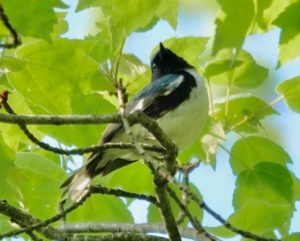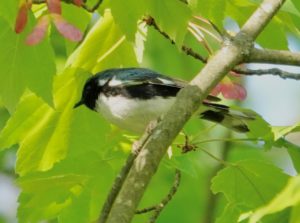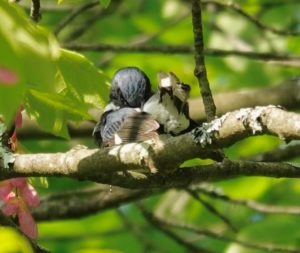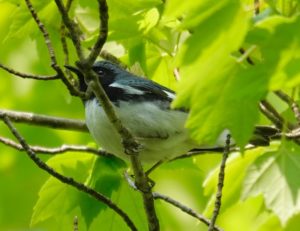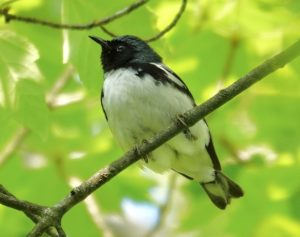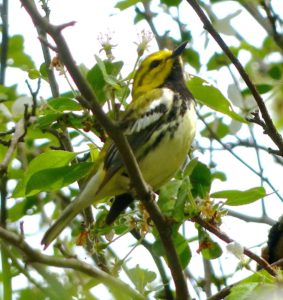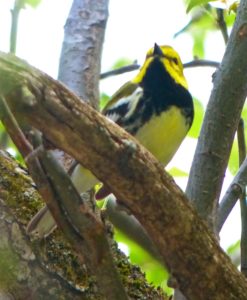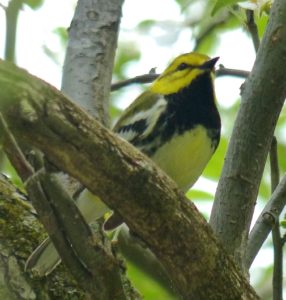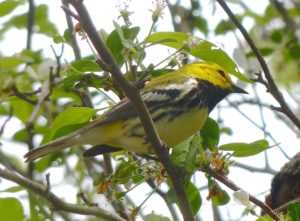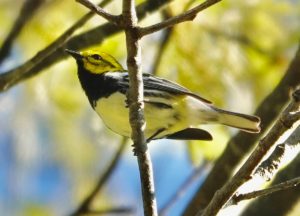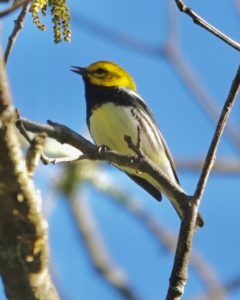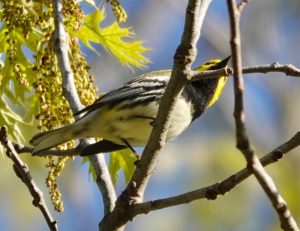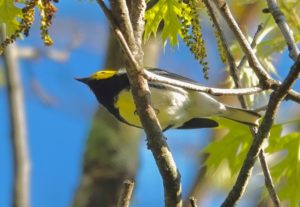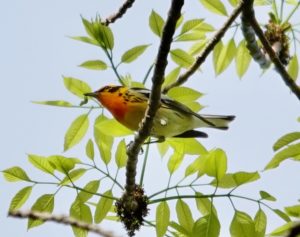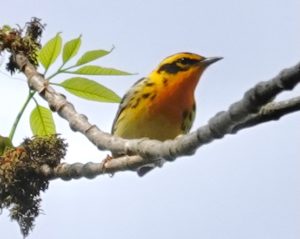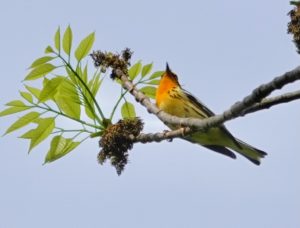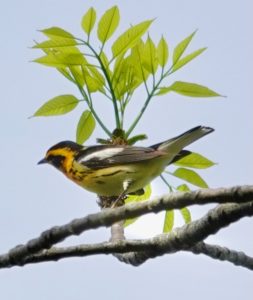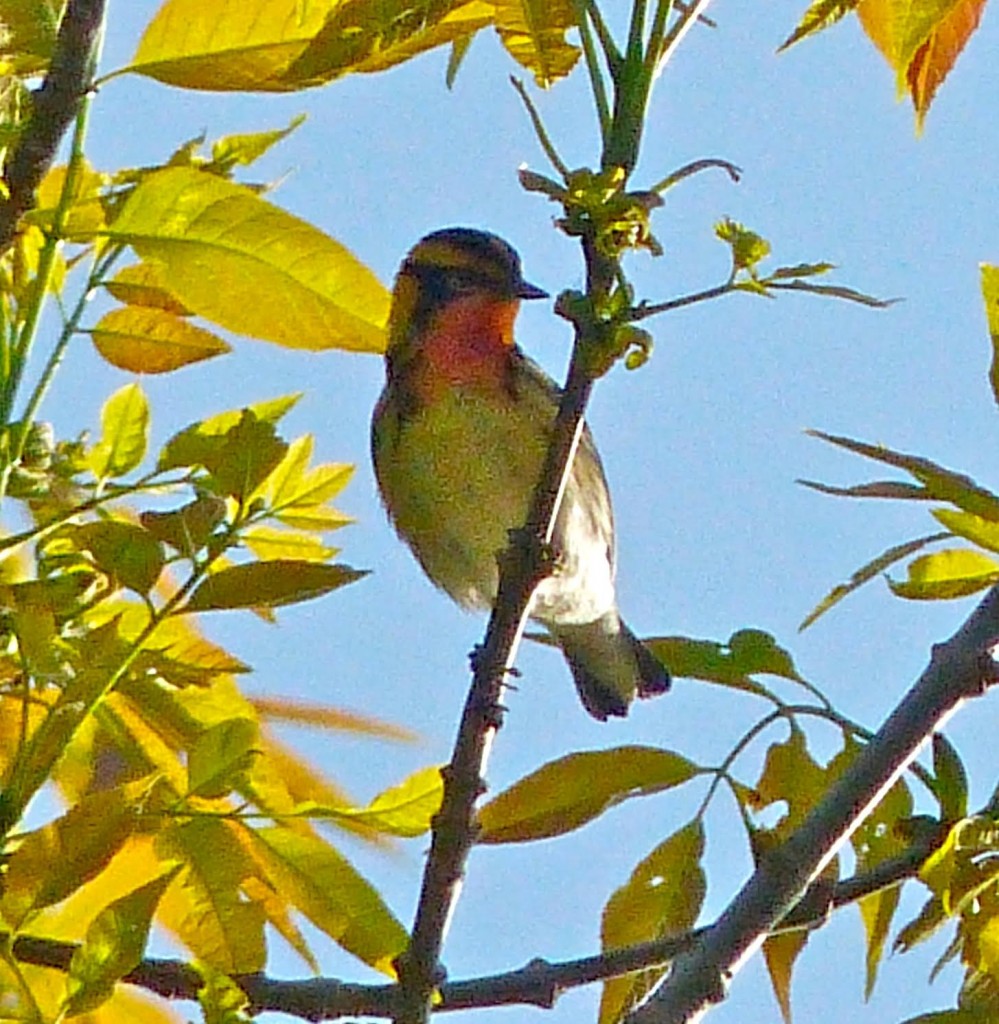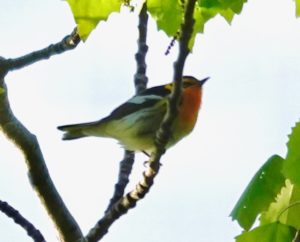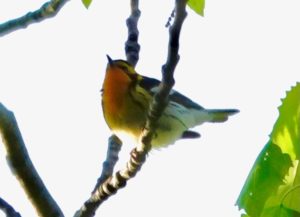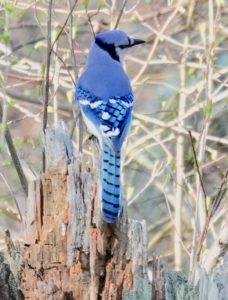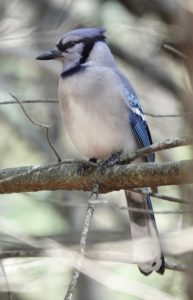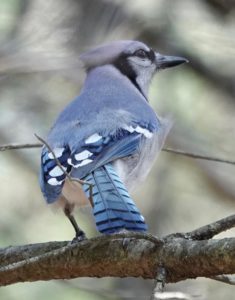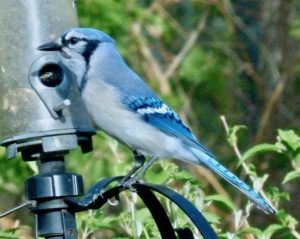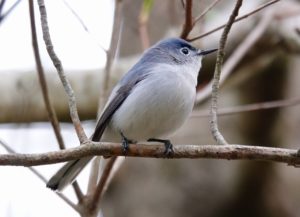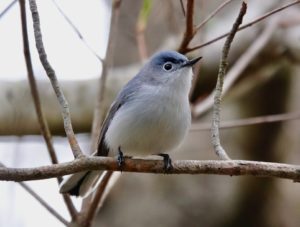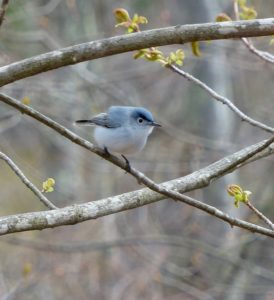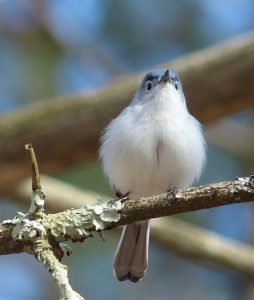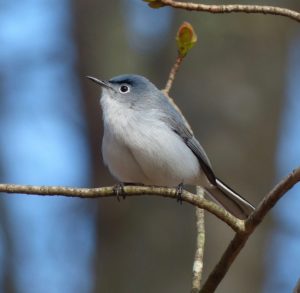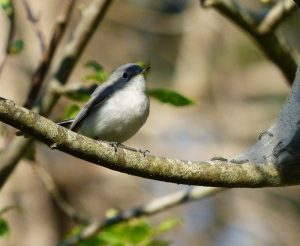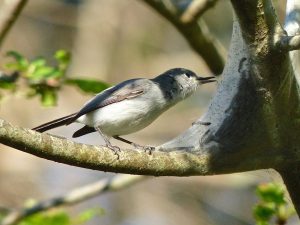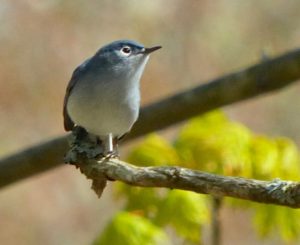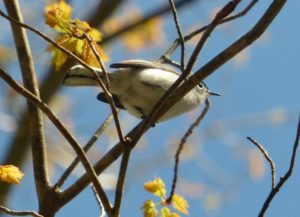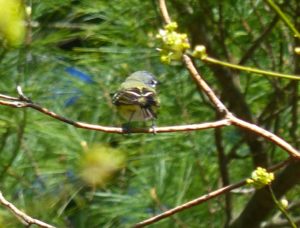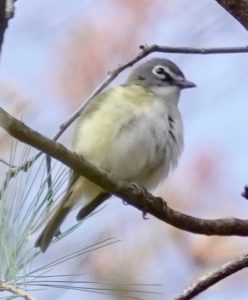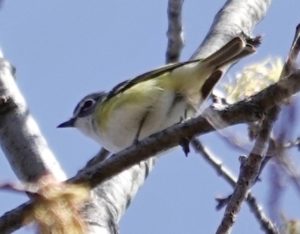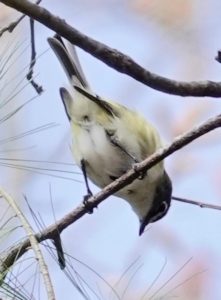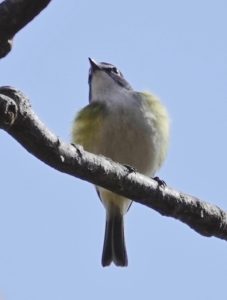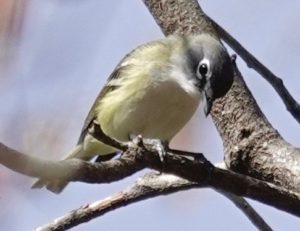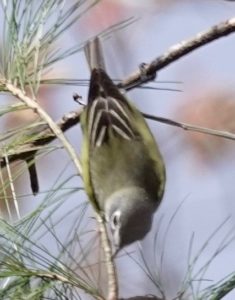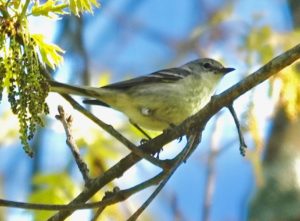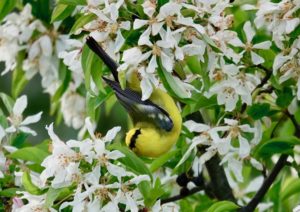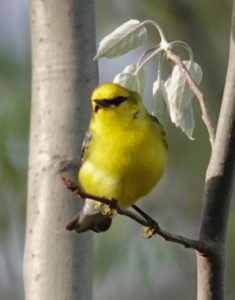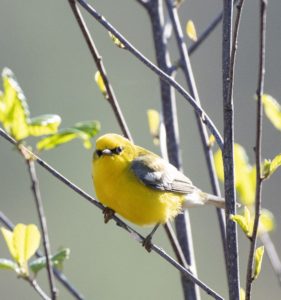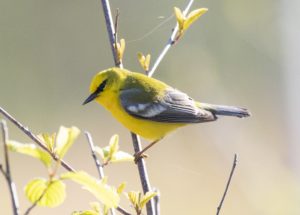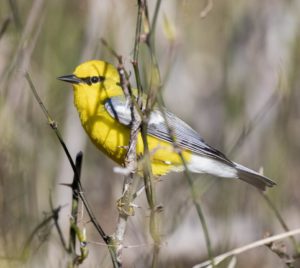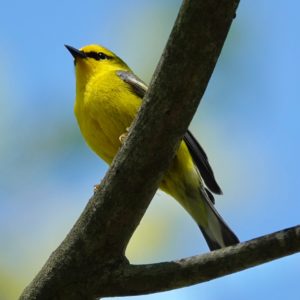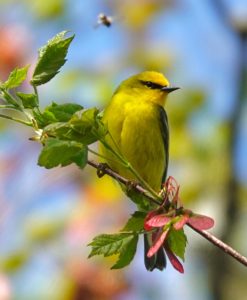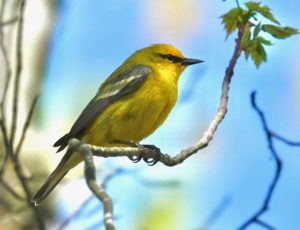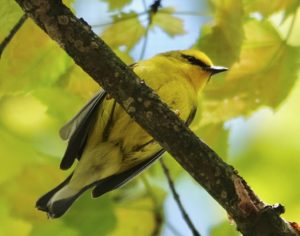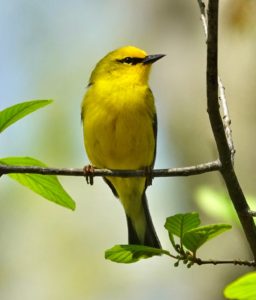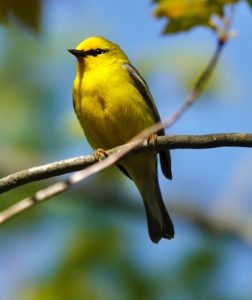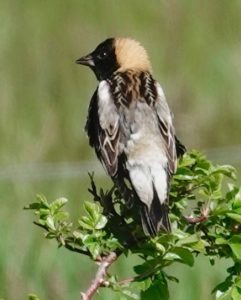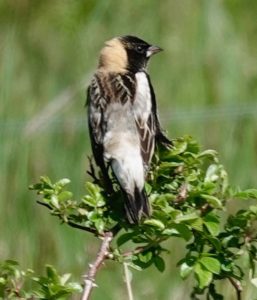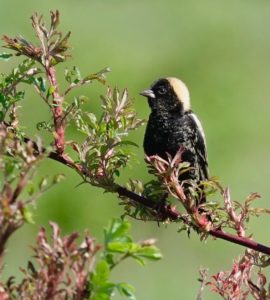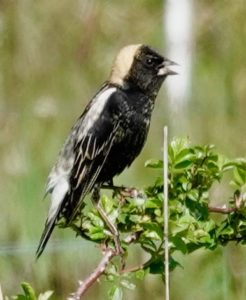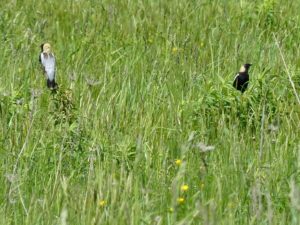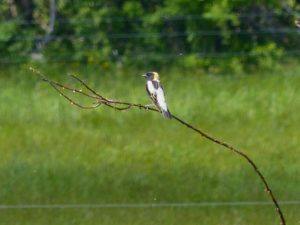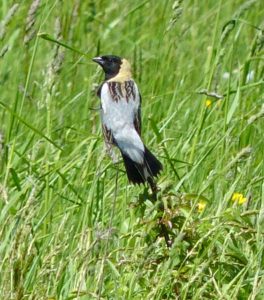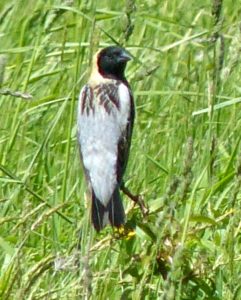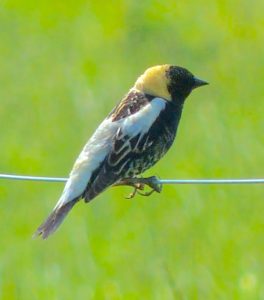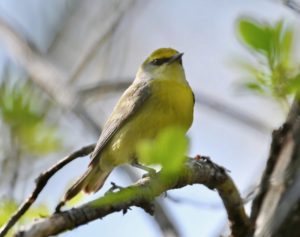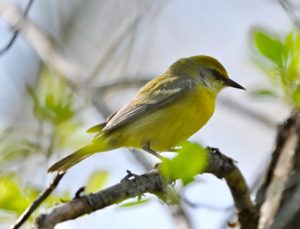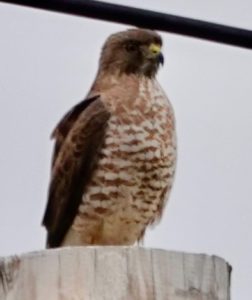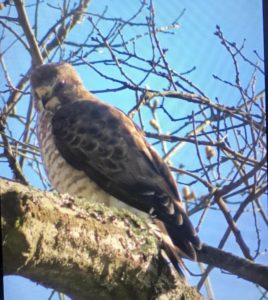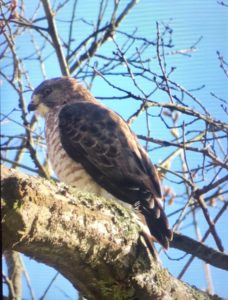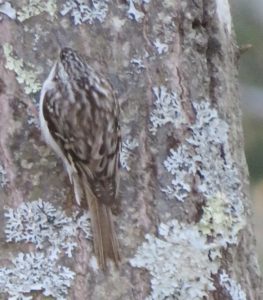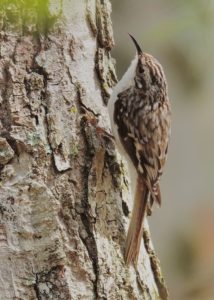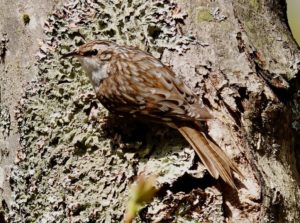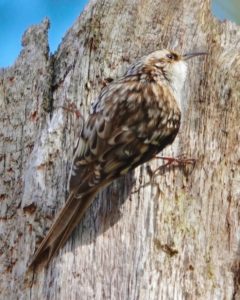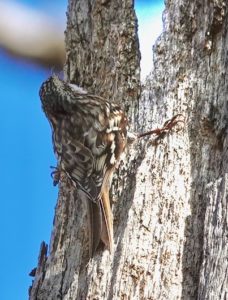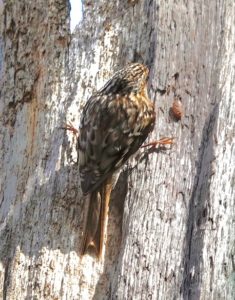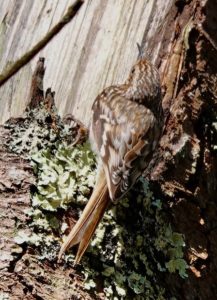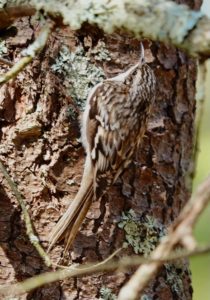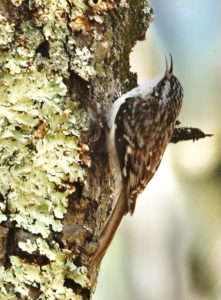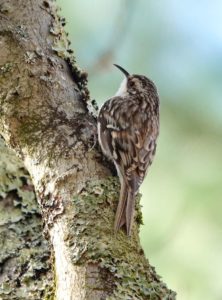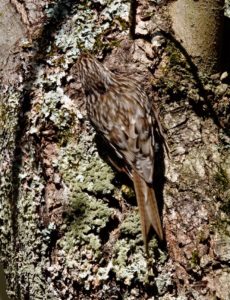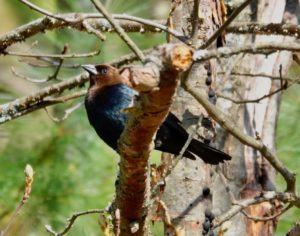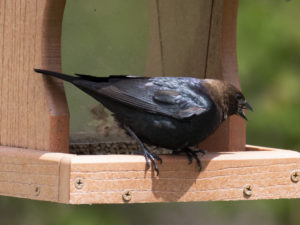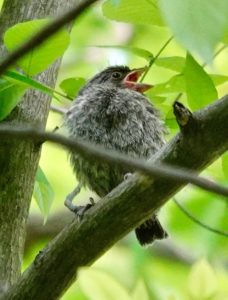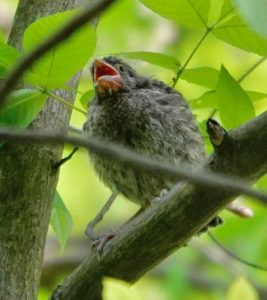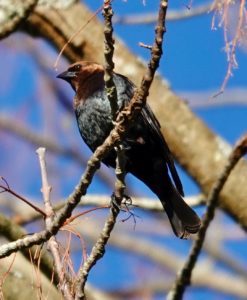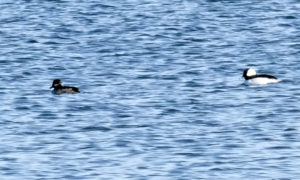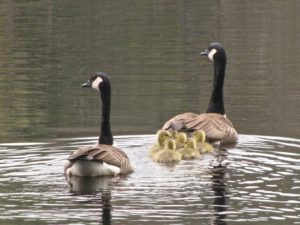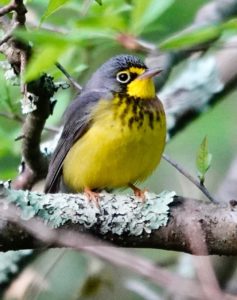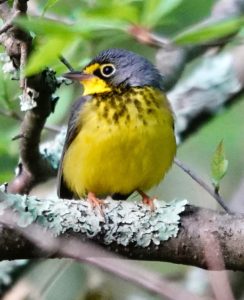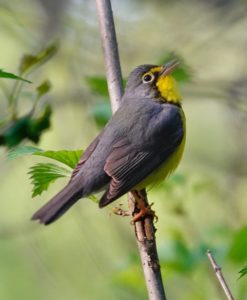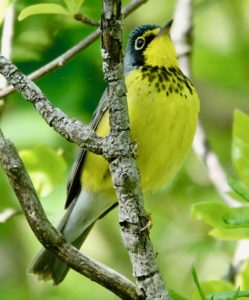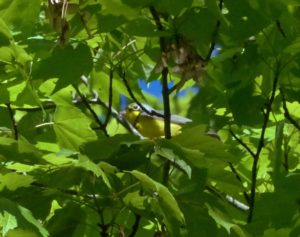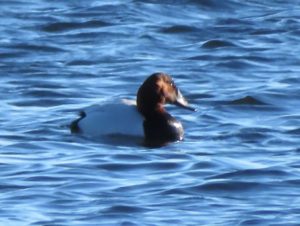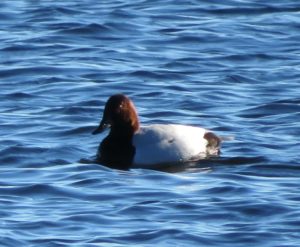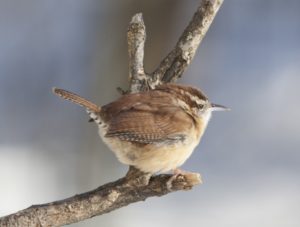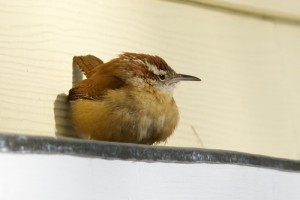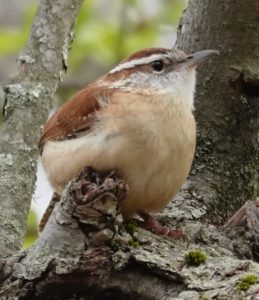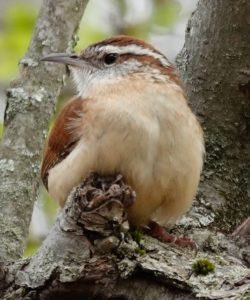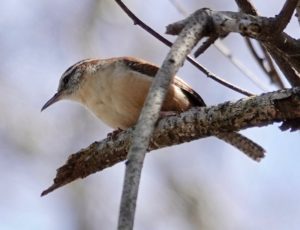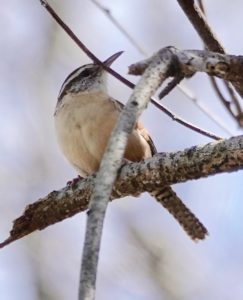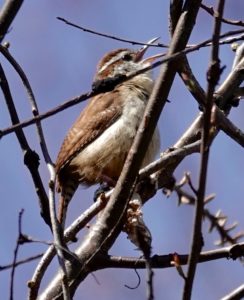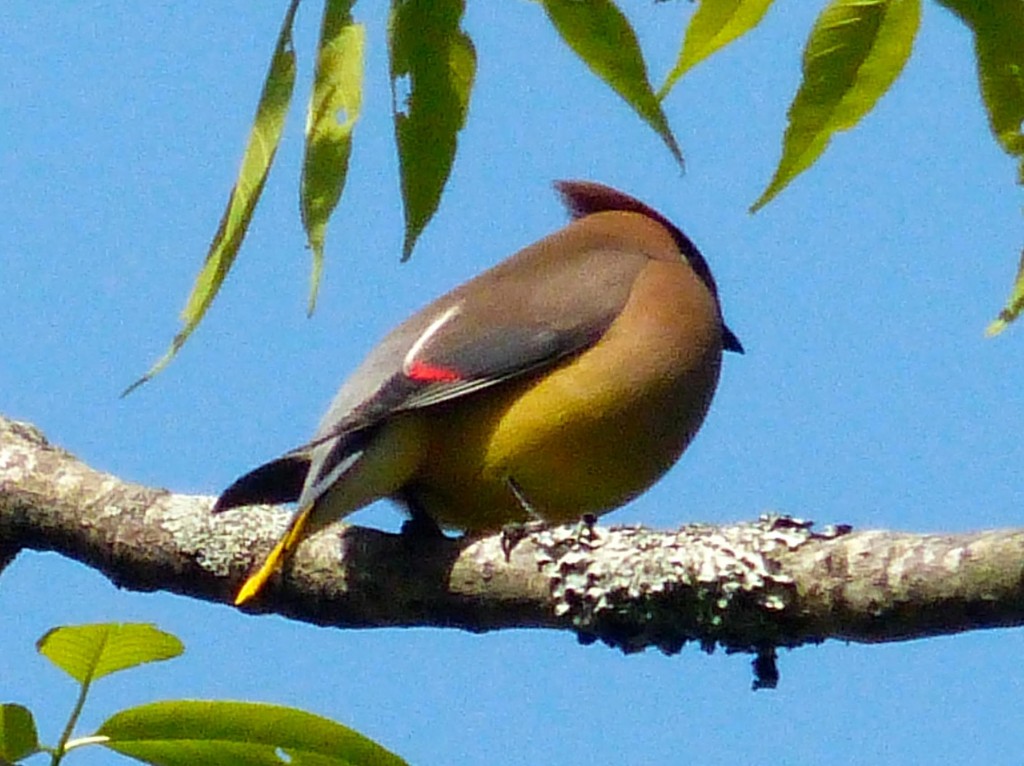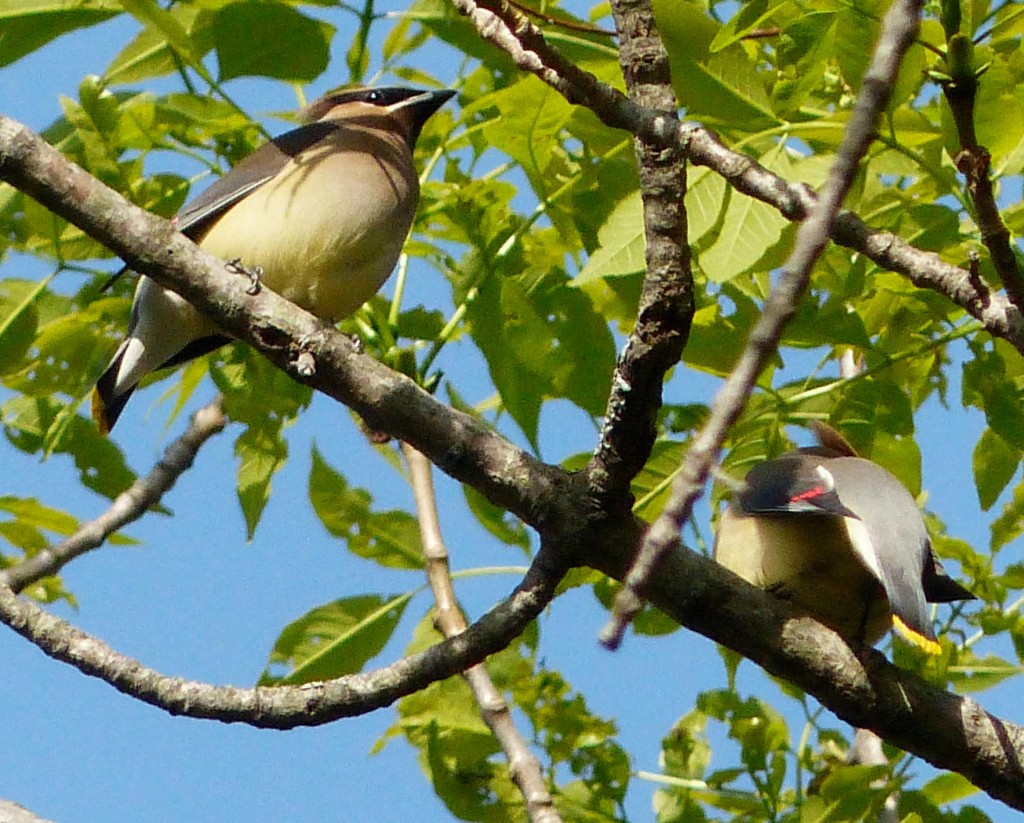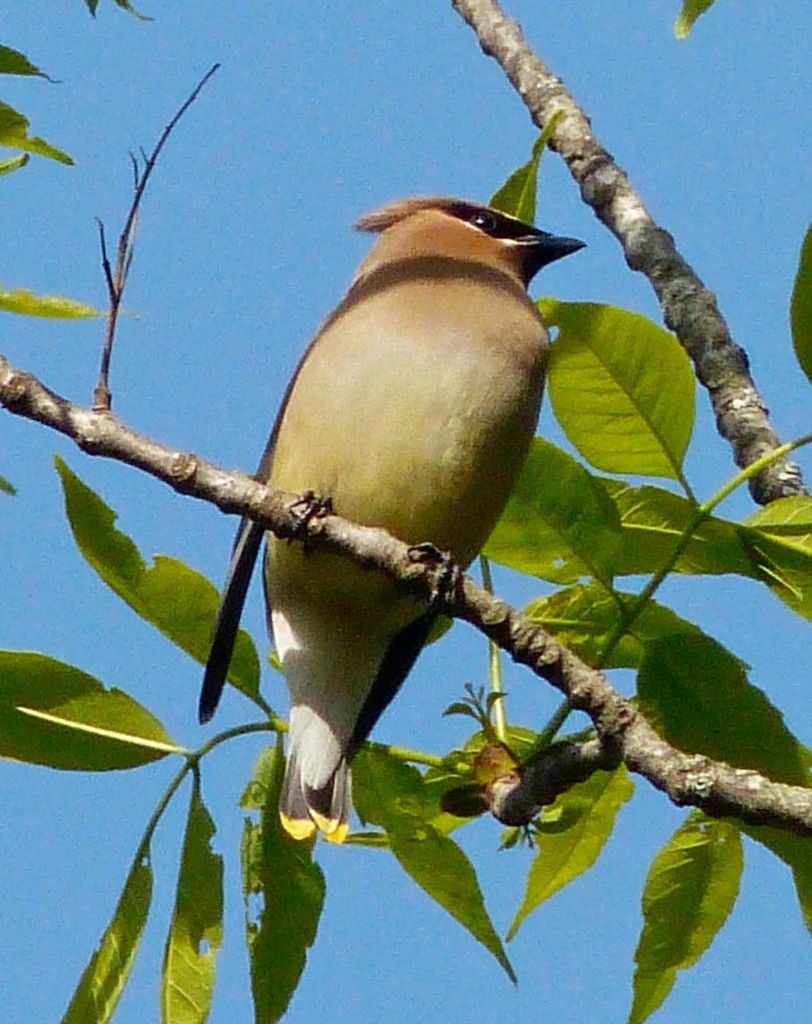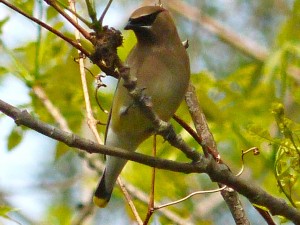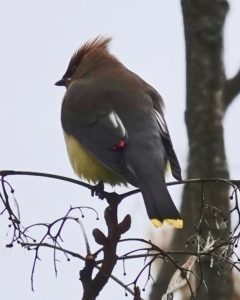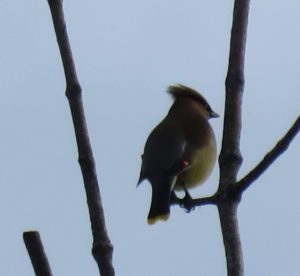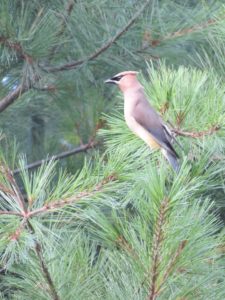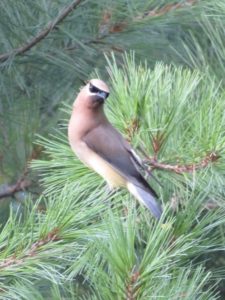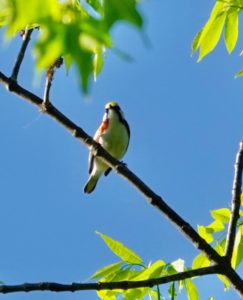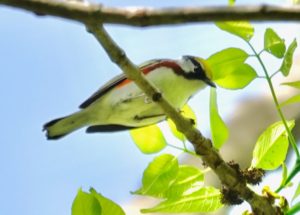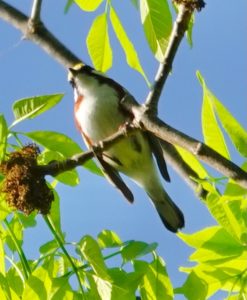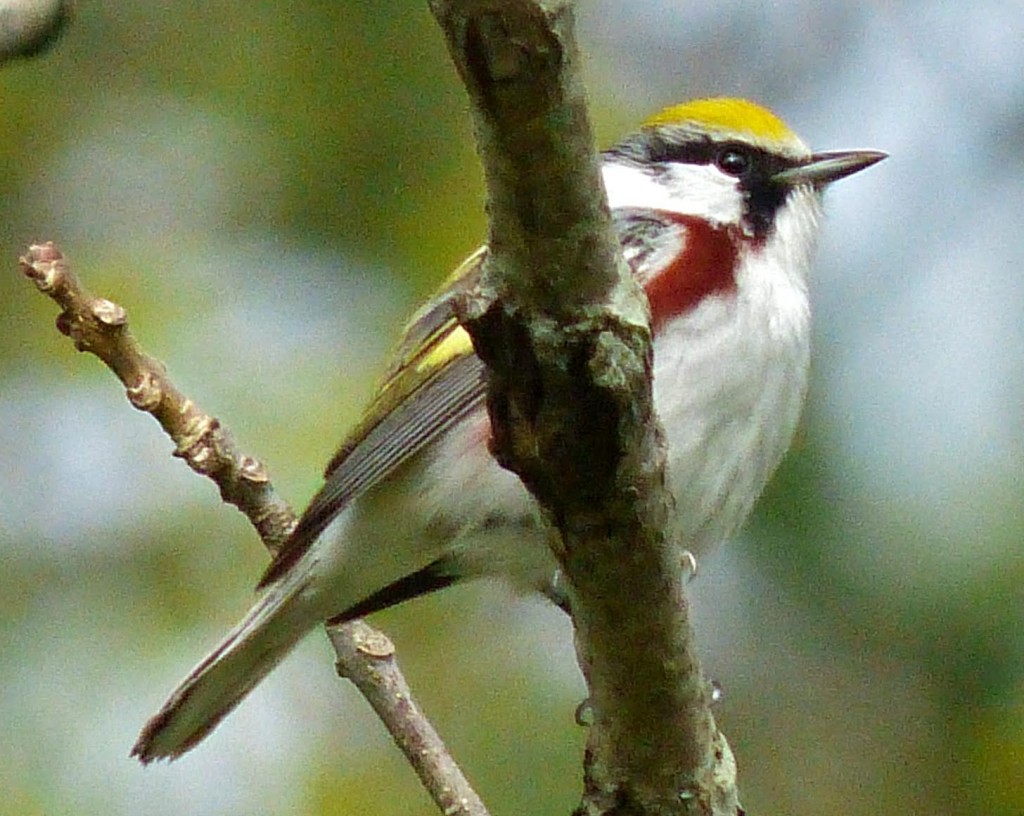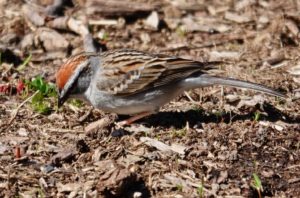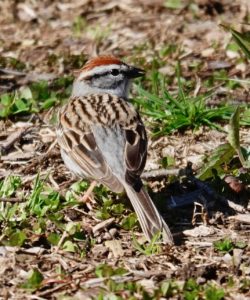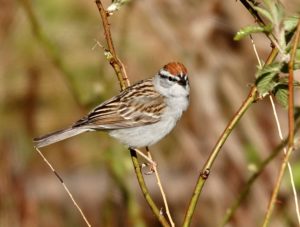Sightings – Birds
Observer: Paul Lauenstein
Observation Date: 5/15/23
Observation Time: 7:45 a.m.
Observation Location: Moose Hill Audubon Wildlife Sanctuary
Common Name: Black-throated Blue Warbler
Scientific Name: Setophaga caerulescens
Comments: Black-throated blue warblers pass through Sharon in early May on their northward migration. Learn to recognize their buzzy “zree–zree–zreeeee” song to improve your chances of seeing one. Check it out at: https://www.youtube.com/watch?v=lPKuQB1bEqs.
You can monitor the bird migration in spring by keeping an eye on the live radar map at: http://birdcast.info/live-migration-maps/
More Information: All About Birds
Observer: Paul Lauenstein
Observation Date: 5/13/15
Observation Time: 11:10 a.m.
Observation Location: Moose Hill Audubon Wildlife Sanctuary
Common Name: Black-throated Green Warbler
Scientific Name: Setophaga virens
Comments: The call of this warbler sounds like: “zee-zee-zee-zoo-zee.” It migrates through Sharon in May. I got these photos standing underneath a flowering crabapple tree. The blossoms attracted insects, which in turn attracted insectivorous warblers.
More Information: All About Birds
Observer: Paul Lauenstein
Observation Date: 5/8/23
Observation Time: 7:05 a.m.
Observation Location: Moose Hill Audubon Wildlife Sanctuary
Common Name: Black-throated Green Warbler
Scientific Name: Setophaga virens
Comments: The call of this warbler sounds like: “zee-zee-zee-zoo-zee.” It migrates through Sharon in early May.
More Information: All About Birds
Observer: Faith Berkland
Observation Date: 9/26/17
Observation Location: 302 Mansfield Street Sharon
Common Name: Black throated green warbler
Scientific Name: Setophaga virens
Comments: A nice collection of photos of black-throated green warblers can be found at: The Internet Bird Collection
More Information: All About Birds
Observer: Paul Lauenstein
Observation Date: 5/12/23
Observation Time: 8:00 a.m.
Observation Location: Moose Hill Audubon Wildlife Sanctuary
Common Name: Blackburnian Warbler
Scientific Name: Setophaga fusca
Comments: These gorgeous warblers overwinter in South America. They tend to flit about high in tall trees, making them a challenge to photograph.
More Information: All About Birds
Observer: Paul Lauenstein
Observation Date: 5/15/15
Observation Time: 7:15 a.m.
Observation Location: Moose Hill Audubon Wildlife Sanctuary
Common Name: Blackburnian Warbler
Scientific Name: Setophaga fusca
Comments: This photo does not do justice to these gorgeous warblers, which overwinter in South America. They tend to flit about high in tall trees, making them a challenge to photograph.
More Information: All About Birds
Observer: Paul Lauenstein
Observation Date: 5/18/23
Observation Time: 6::25 a.m.
Observation Location: Moose Hill Audubon Wildlife Sanctuary
Common Name: Blackburnian Warbler
Scientific Name: Setophaga fusca
Comments: These gorgeous warblers overwinter in South America. They tend to flit about high in tall trees, making them a challenge to photograph.
More Information: All About Birds
Observer: Paul Lauenstein
Observation Date: 11/19/12
Observation Time: 10:25 a.m.
Observation Location: 4 Gavins Pond Road
Common Name: Blue Jay
Scientific Name: Cyanocitta cristata
Comments: Blue Jays are common in Sharon. They eat insects and nuts. They will also eat the eggs and nestlings of other birds if they get the chance. They can live up to 17 years.
More Information: All About Birds
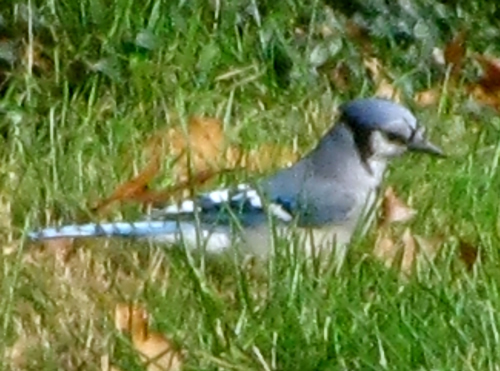
Observer: Paul Lauenstein
Observation Date: 5/11/20
Observation Time: 7:30 a.m.
Observation Location: woods beyond Gavins Pond dam
Common Name: Blue Jay
Scientific Name: Cyanocitta cristata
Comments: Blue Jays are common in Sharon. They eat insects, nuts and seeds. They will also eat the eggs and nestlings of other birds if they get the chance. They can live up to 17 years. Their vocalizations are distinctive and varied.
Blue Jays have an astonishing array of vocalizations. If you learn to recognize them, you won’t be fooled into thinking you are hearing an exotic bird in the woods. Check it out at: https://www.allaboutbirds.org/guide/Blue_Jay/sounds
More Information: All About Birds
Observer: Paul Lauenstein
Observation Date: 5/3/20
Observation Time: 10:35 a.m.
Observation Location: woods near Gavins Pond
Common Name: Blue Jay
Scientific Name: Cyanocitta cristata
Comments: Blue Jays are common in Sharon. They eat insects, nuts and seeds. They will also eat the eggs and nestlings of other birds if they get the chance. They can live up to 17 years. Their vocalizations are distinctive and varied.
Blue Jays have an astonishing array of vocalizations. If you learn to recognize them, you won’t be fooled into thinking you are hearing an exotic bird in the woods. Check it out at: https://www.allaboutbirds.org/guide/Blue_Jay/sounds
More Information: All About Birds
Observer: Paul Lauenstein
Observation Date: 5/5/18
Observation Time: 7:30 a.m.
Observation Location: Moose Hill Audubon Wildlife Sanctuary
Common Name: Blue Jay
Scientific Name: Cyanocitta cristata
Comments: Blue Jays are common in Sharon. They eat insects, nuts and seeds. They will also eat the eggs and nestlings of other birds if they get the chance. They can live up to 17 years. Their vocalizations are distinctive and varied.
More Information: All About Birds
Observer: Paul Lauenstein
Observation Date: 4/26/23
Observation Time: 6:00 am
Observation Location: Moose Hill Audubon Wildlife Sanctuary
Common Name: Blue-gray gnatcatcher
Scientific Name: Polioptila caerulea
Comments: The blue-gray gnatcatcher is the northernmost-occurring species of gnatcatcher, and the only truly migratory one. Most members of its genus are resident in Central and South America.
The nesting range of blue-gray gnatcatchers has been shifting northward since the early twentieth century. Over the last quarter of that century, the shift was about 200 miles, in concert with increasing average temperatures.
More Information: All About Birds
Observer: Paul Lauenstein
Contact Information: lauenstein@comcast.net (781) 784-2986
Observation Date: 5/1/18 at 8:15 a.m.
Observation Location: Moose Hill Audubon Wildlife Sanctuary
Common Name: Blue-gray gnatcatcher
Scientific Name: Polioptila caerulea
Comments: A tiny, long-tailed bird of broadleaf forests and scrublands, the Blue-gray Gnatcatcher makes itself known by its soft but insistent calls and its constant motion. It hops and sidles in dense outer foliage, foraging for insects and spiders. As it moves, this steely blue-gray bird conspicuously flicks its white-edged tail from side to side, scaring up insects and chasing after them. Pairs use spiderweb and lichens to build small, neat nests, which sit on top of branches and look like tree knots.
More Information: All About Birds
Observer: Paul Lauenstein
Observation Date: 5/11/16
Observation Time: 7:45 a.m.
Observation Location: Moose Hill Audubon Wildlife Center
Common Name: Blue-gray gnatcatcher
Scientific Name: Polioptila caerulea
Comments: The blue-gray gnatcatcher is a tiny, long-tailed bird of broadleaf forests and scrublands. It makes itself known by its soft but insistent calls and its constant motion. It hops and sidles in dense outer foliage, foraging for insects and spiders. As it moves, it conspicuously flicks its white-edged tail from side to side, scaring up insects and chasing after them. Pairs use spiderweb and lichens to build small, neat nests, which sit on top of branches and look like tree knots.
Note the tent caterpillars on the branch beside the bird.
More Information: All About Birds
Observer: Paul Lauenstein
Observation Date: 5/5/23
Observation Time: 12:35 pm
Observation Location: Moose Hill Audubon Wildlife Sanctuary
Common Name: Blue-gray gnatcatcher
Scientific Name: Polioptila caerulea
Comments: The blue-gray gnatcatcher is the northernmost-occurring species of gnatcatcher, and the only truly migratory one. Most members of its genus are resident in Central and South America.
The nesting range of blue-gray gnatcatchers has been shifting northward since the early twentieth century. Over the last quarter of that century, the shift was about 200 miles, in concert with increasing average temperatures.
More Information: All About Birds
Observer: Paul Lauenstein
Observation Date: 5/8/19
Observation Time: 9:15 a.m.
Observation Location: Moose Hill Audubon Wildlife Sanctuary
Common Name: Blue-gray gnatcatcher
Scientific Name: Polioptila caerulea
Comments: The blue-gray gnatcatcher is the northernmost-occurring species of gnatcatcher, and the only truly migratory one. Most members of its genus are resident in Central and South America.
The nesting range of blue-gray gnatcatchers has been shifting northward since the early twentieth century. Over the last quarter of that century, the shift was about 200 miles, in concert with increasing average temperatures.
More Information: All About Birds
Observer: Paul Lauenstein
Observation Date: 5/7/19
Observation Time: 8:28 a.m.
Observation Location: Moose Hill Audubon Wildlife Sanctuary
Common Name: Blue-headed Vireo
Scientific Name: Vireo solitarius
Comments: Sorry about the poor picture quality. My challenge to you is to get out there and take a better one! Learn to recognize the song so you will know when you are near one. The best time to find one is in May as they migrate through Sharon on their way north.
More Information: All About Birds
Observer: Paul Lauenstein
Observation Date: 5/7/20
Observation Time: 9:30 a.m.
Observation Location: Conservation land at Lakeview & Morse Streets
Common Name: Blue-headed Vireo
Scientific Name: Vireo solitarius
Comments: The woods were pretty quiet this morning. After walking a long way along a trail, I heard this blue-headed vireo singing high in the treetops. These photos were taken with my new Sony RX-10 iv zoom camera.
Note the bold white “spectacles” around its eyes.
More Information: All About Birds
Observer: Paul Lauenstein
Observation Date: 5/8/23
Observation Time: 7:00 a.m.
Observation Location: Moose Hill Audubon Wildlife Sanctuary
Common Name: Blue-headed Vireo
Scientific Name: Vireo solitarius
Comments: I took this photo of a blue-headed vireo thinking it was a warbler of some kind. When I got home and uploaded my photos to my computer, I discovered it was a vireo, not a warbler.
Note the white “spectacles” around its eyes.
More Information: All About Birds
Observer: Paul Lauenstein
Observation Date: 5/16/20
Observation Time: 7:10 a.m.
Observation Location: near the soccer field parking lot at Gavins Pond
Common Name: Blue-winged warbler
Scientific Name: Vermivora cyanoptera
Comments: The blue-winged warbler’s song sounds like, “bee-buzz.” Note the distinctive mask-like black line through its eyes.
More Information: All About Birds
Observer: Paul Lauenstein
Observation Date: 5/19/14
Observation Time: 11:30 a.m.
Observation Location: Gavins Pond Road
Common Name: Blue-winged Warbler
Scientific Name: Vermivora cyanoptera
Comments: The blue-winged warbler’s song sounds like, “bee-buzz.”
More Information: All About Birds
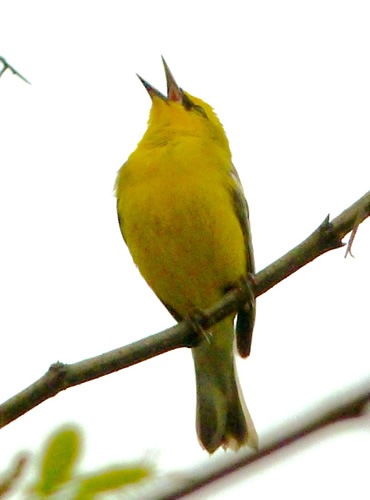
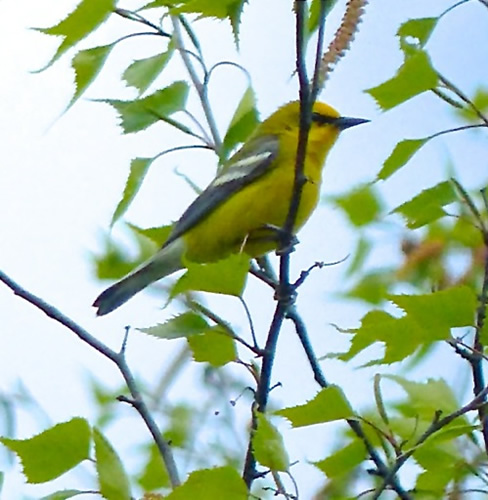
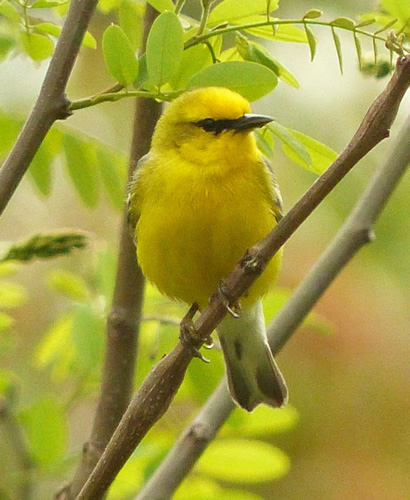
Observer: Jason Platt
Observation Date: 5/8/18
Observation Time: 8:45 a.m.
Observation Location: under power lines at Moose Hill
Common Name: Blue-winged Warbler
Scientific Name: Vermivora cyanoptera
Comments: The blue-winged warbler’s song sounds like, “bee-buzz.”
More Information: All About Birds
Observer: Paul Lauenstein
Observation Date: 5/8/23
Observation Time: 10:30 a.m.
Observation Location: Moose Hill Audubon Wildlife Sanctuary
Common Name: Blue-winged warbler
Scientific Name: Vermivora cyanoptera
Comments: The blue-winged warbler’s song sounds like, “bee-buzz.” Note the distinctive mask-like black line through its eyes.
More Information: All About Birds
Observer: Paul Lauenstein
Observation Date: 5/21/20
Observation Time: 9:30 a.m.
Observation Location: Moose Hill Farm (formerly the Kendall Estate)
Common Name: Bobolink
Scientific Name: Dolichonyx oryzivorus
Comments: The big pasture at the Trustees of Reservations’ Moose Hill Farm is ideal breeding habitat for bobolinks. Meadow habitat is not nearly as prevalent in Massachusetts since industry replaced agriculture, and forests grew back in former pasture lands.
More Information: All About Birds
Observer: Paul Lauenstein
Observation Date: 5/26/19
Observation Time: 2:00 p.m.
Observation Location: Moose Hill Farm (formerly the Kendall Estate)
Common Name: Bobolink
Scientific Name: Dolichonyx oryzivorus
Comments: The big pasture at Moose Hill Farm is ideal breeding habitat for bobolinks. Meadow habitat is not nearly as prevalent in Massachusetts since industry replaced agriculture, and forests grew back in former farmlands.
More Information: All About Birds
Observer: Daniel O’Brien
Observation Date: 5/20/23
Observation Time: 9:00 a.m.
Observation Location: Moose Hill Audubon Wildlife Sanctuary
Common Name: Brewster’s Warbler (hybrid)
Scientific Name: Vermivora chrysoptera x cyanoptera
Comments: Brewster’s warblers are actually a hybrid between golden-winged warblers and blue-winged warblers. These two species are 99.7% alike genetically.
More Information: All About Birds
Observer: Paul Lauenstein
Observation Date: 4/21/24
Observation Time: 1:30
Observation Location: telephone pole by Beach Street near Sharon High School
Common Name: Broad-winged hawk
Scientific Name: Buteo platypterus
Comments: A small, stocky raptor with black-and-white bands on the tail, the Broad-winged Hawk is a bird of the forest interior and can be hard to see during the nesting season. Its call is a piercing, two-parted whistle.
One of the greatest spectacles of migration is a swirling flock of Broad-winged Hawks on their way to South America. Also known as “kettles,” flocks can contain thousands of circling birds that evoke a vast cauldron being stirred with an invisible spoon.
More Information: All About Birds
Observer: Deborah Radovsky
Observation Date: 4/28/22
Observation Time: early evening
Observation Location: Moose Hill, near nature center
Common Name: Broad-winged hawk
Scientific Name: Buteo platypterus
Comments: A small, stocky raptor with black-and-white bands on the tail, the Broad-winged Hawk is a bird of the forest interior and can be hard to see during the nesting season. Its call is a piercing, two-parted whistle.
One of the greatest spectacles of migration is a swirling flock of Broad-winged Hawks on their way to South America. Also known as “kettles,” flocks can contain thousands of circling birds that evoke a vast cauldron being stirred with an invisible spoon.
More Information: All About Birds
Observer: Deb Radovsky
Observation Date: 4/23/18
Observation Time: 6:00 p.m.
Observation Location: Moose Hill Audubon Wildlife Sanctuary (Billings Loop)
Common Name: Brown Creeper
Scientific Name: Certhia americana
Comments: Brown Creepers are tiny woodland birds with an affinity for the biggest trees they can find. Look for these little, long-tailed scraps of brown and white spiraling up stout trunks and main branches, sometimes passing downward-facing nuthatches along the way. They probe into crevices and pick at loose bark with their slender, downcurved bills, and build their hammock-shaped nests behind peeling flakes of bark. Their piercing calls can make it much easier to find this hard-to-see but common species.
More Information: All About Birds
Observer: Paul Lauenstein
Observation Date: 4/28/23
Observation Time: 9:30 a.m.
Observation Location: Moose Hill Audubon Wildlife Sanctuary
Common Name: Brown Creeper
Scientific Name: Certhia americana
Comments: Brown creepers are tiny woodland birds with an affinity for the biggest trees they can find. Look for these little, long-tailed scraps of brown and white spiraling up stout trunks and main branches. Their curved claws allow them to creep up the trunks of trees but not down, so when they reach the top they fly back down.
They probe into crevices and pick at loose bark with their slender, downcurved bills, and build their hammock-shaped nests behind peeling flakes of bark. Their high-pitched squeaky calls help find this hard-to-see but common species.
More Information: All About Birds
Brown creepers are well-camouflaged!
Observer: Paul Lauenstein
Observation Date: 5/2/11
Observation Time: 4:20 p.m.
Observation Location: Gavins Pond Road near soccer field parking lot
Common Name: Brown Thrasher
Scientific Name: Toxostoma rufum
Comments: Brown thrashers are one of the three mimics. The other two are catbirds and mockingbirds. Brown thrashers repeat each vocalization twice. Mockingbirds repeat three or four times. Catbirds only make each vocalization once.
More Information: All About Birds.org
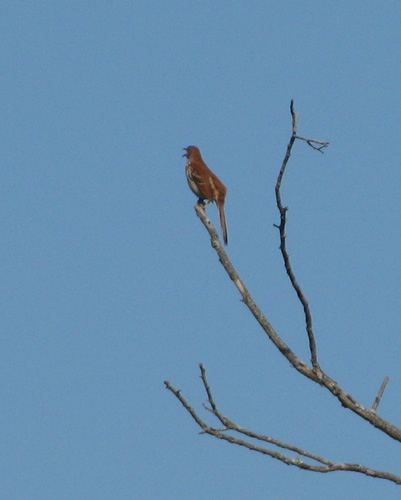
Observer: Paul Lauenstein
Observation Date: 4/28/23
Observation Time: 8:30 a.m.
Observation Location: Moose Hill Audubon Wildlife Sanctuary
Common Name: Brown-headed Cowbird
Scientific Name: Molothrus ater
Comments: Brown-headed Cowbirds parasitize other bird species. Female Cowbirds forgo building nests and instead lay their eggs in the nests of other birds, abandoning their young to foster parents, usually at the expense of at least some of the host’s own chicks. Once confined to the open grasslands of middle North America, cowbirds have surged in numbers and range as humans built towns and cleared woods.
More Information: All About Birds.org
Observer: Paul Lauenstein
Observation Date: 4/7/14
Observation Time: 12:10 p.m.
Observation Location: Gavins Pond area near soccer fields
Common Name: Brown-headed Cowbird
Scientific Name: Molothrus ater
Comments: These Brown-headed Cowbirds were mating. Cowbirds parasitize other bird species. Female Cowbirds forgo building nests and instead lay their eggs in the nests of other birds, abandoning their young to foster parents, usually at the expense of at least some of the host’s own chicks. Once confined to the open grasslands of middle North America, cowbirds have surged in numbers and range as humans built towns and cleared woods.
More Information: All About Birds.org
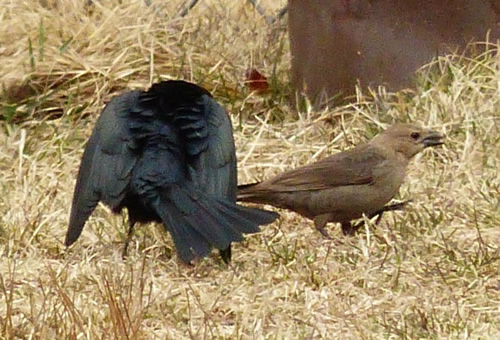
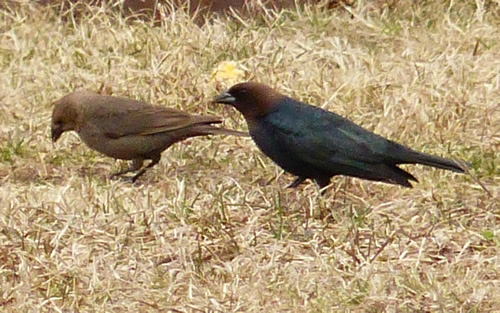
Observer: Josh Simons
Observation Date: 5/10/20
Observation Time: 1:00 p.m.
Observation Location: Moose Hill area
Common Name: Brown-headed Cowbird
Scientific Name: Molothrus ater
Comments: Cowbirds parasitize other bird species. Female Cowbirds forgo building nests and instead lay their eggs in the nests of other birds, abandoning their young to foster parents, usually at the expense of at least some of the host’s own chicks. Once confined to the open grasslands of middle North America, cowbirds have surged in numbers and range as humans built towns and cleared woods.
More Information: All About Birds
Observer: Paul Lauenstein
Observation Date: 5-16-23
Observation Time: 7:30 a.m.
Observation Location: Moose Hill Audubon Wildlife Sanctuary
Common Name: Brown-headed Cowbird (fledgling)
Scientific Name: Molothrus ater
Comments: Brown-headed Cowbirds parasitize other bird species. Female Cowbirds forgo building nests and instead lay their eggs in the nests of other birds, abandoning their young to foster parents, usually at the expense of at least some of the host’s own chicks. This begging fledgling had left the nest, but was still being fed by its surrogate parent – a phoebe.
More Information: All About Birds.org
Observer: Paul Lauenstein
Observation Date: 5/7/23
Observation Time: 6:30 a.m.
Observation Location: Moose Hill Audubon Wildlife Sanctuary
Common Name: Brown-headed Cowbird (male)
Scientific Name: Molothrus ater
Comments: Brown-headed Cowbirds parasitize other bird species. Female Cowbirds forgo building nests and instead lay their eggs in the nests of other birds, abandoning their young to foster parents, usually at the expense of at least some of the host’s own chicks. Once confined to the open grasslands of middle North America, cowbirds have surged in numbers and range as humans built towns and cleared woods.
More Information: All About Birds.org
Observer: Paul Lauenstein
Observation Date: 11/19/13
Observation Time: 2:35 p.m.
Observation Location: Gavins Pond
Common Name: Bufflehead
Scientific Name: Bucephala albeola
Comments: Buffleheads are small, diving ducks. They nest in old woodpecker holes, particularly those made by Northern Flickers, in the forests of northern North America.
More Information: All About Birds
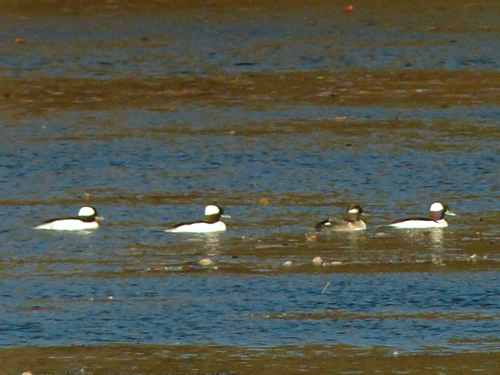
Observer: Ilan Fisher
Observation Date: 3/8/20
Observation Time: 3:00 p.m.
Observation Location: Lake Massapoag (near Harding St. & Beach St.)
Common Name: Bufflehead
Scientific Name: Bucephala albeola
Comments: Shot a bit of video to go with previous days’ sightings at same location. See: https://www.youtube.com/watch?v=OdOIPxBSs1g
More Information: All About Birds
Observer: Paul Lauenstein
Observation Date: 5/4/11
Observation Time: 12:45 p.m.
Observation Location: Gavins Pond
Common Name: Canada Goose
Scientific Name: Branta canadensis
Comments: Canada geese are quite common in Sharon, and can even become a nuisance, but these goslings sure are cute. If you are in the mood for a heartwarming movie, see “Fly Away Home” about a girl who adopts some orphaned goslings.
More Information: Mass Wildlife
Observer: Paul Lauenstein
Observation Date: 5/14/23
Observation Time: 6:45 a.m.
Observation Location: Moose Hill Audubon Wildlife Sanctuary
Common Name: Canada Warbler
Scientific Name: Cardellina canadensis
Comments: Canada Warblers migrate through Sharon in mid-May. They have a distinctive black collar and a white eye-ring.
More Information: All About Birds
Observer: Paul Lauenstein
Observation Date: 5/18/23
Observation Time: 8:40 a.m.
Observation Location: Moose Hill Audubon Wildlife Sanctuary
Common Name: Canada Warbler
Scientific Name: Cardellina canadensis
Comments: Canada Warblers migrate through Sharon in mid-May. They have a distinctive black collar and a white eye-ring.
More Information: All About Birds
Observer: Paul Lauenstein
Observation Date: 5/21/18
Observation Time: 7:50 a.m.
Observation Location: Moose Hill Audubon Wildlife Sanctuary
Common Name: Canada Warbler
Scientific Name: Cardellina canadensis
Comments: Canada Warblers migrate through Sharon in mid-May. They have a distinctive black collar and a white eye-ring.
More Information: All About Birds
Observer: Paul Lauenstein
Observation Date: 3/12/09
Observation Time: 7:45 a.m.
Observation Location: Soccer field by Gavins Pond Road
Common Name: Canada x Greylag hybrid goose
Scientific Name:
Comments: This morning I saw a strange goose among the Canada geese at the Gavins Pond soccer field nearest to Gavins Pond Road. It had a distinct white line all the way around the base of its dark beak, light gray cheeks with a dark head and neck, and dull orange legs (the Canada geese had black legs). The transition from the gray cheeks to the dark head was not as sharp as that of the Canada geese, and the gray cheek patch was quite a bit larger than the white “chin strap” of the Canada geese. The body and rump were very similar to the Canada geese. It looked like the some of the Canada x Greylag hybrids shown here except that it had a dark beak, and the white line around the base of the beak was more distinct.
I watched it fly in alone and land on the field among the Canada geese, which is why I noticed it in the first place.
This goose looked exactly like one photographed by Will Sweet earlier this winter. See:
http://www.flickr.com/photos/22560927@N04/3320242349/
http://www.flickr.com/photos/22560927@N04/3320241847/
More Information: Flickr: Hybrid Birds
Observer: Deb Radovsky
Observation Date: 2/27/18
Observation Time: afternoon
Observation Location: Lake Massapoag
Common Name: Canvasback duck
Scientific Name: Aythya valisineria
Comments: The species name of the Canvasback, Aythya valisineria, comes from Vallisneria americana, or wild celery, whose winter buds and rhizomes are its preferred food during the nonbreeding period.
The oldest recorded Canvasback was a male and at least 22 years, 7 months old when he was shot in California in 1991. He had been banded in the same state in 1969.
More Information: All About Birds
Observer: Josh Simons
Observation Date: 1/1/09
Observation Time: 2:00 p.m.
Observation Location: Moose Hill Parkway
Common Name: Carolina Wren
Scientific Name: Thryothorus ludovicianus
Comments: This and the titmouse and junco photos were all taken with a Canon 50D and a Canon 500mm f4 lens from the comfort of my kitchen on Moose Hill Parkway. We have feeders that attract lots of birds who land on a nearby lilac bush while waiting for their turn at the feeders.
In terms of processing, I use very little. The images are cropped and very small
adjustments are made to exposure and contrast with sometimes a little extra sharpening applied.
That and the nice, slanting winter sunlight are all there is to it.
More Information: Cornell Lab of Ornithology “All About Birds”
Observer: Paul Lauenstein
Observation Date: 1/17/11
Observation Time: 3:40 p.m.
Observation Location: 284 Mountain Street
Common Name: Carolina Wren
Scientific Name: Thryothorus ludovicianus
Comments: Following the SFOC walk on Martin Luther King Day (January 17), while sipping hot cider at Vera Cross’s house at about 3:40 p.m., a pair of Carolina wrens appeared out the window. It was only 20 degrees outside. The wrens were flitting in and out of an old, unused flue, presumably trying to stay warm. When they perched on a nearby branch, they fluffed their feathers for better insulation.
The Carolina Wren is sensitive to cold weather, with the northern populations decreasing markedly after severe winters. Gradually warming winter temperatures over the last century may be responsible for the northward range expansion seen in the late-1900s and early 2000’s.
A pair bond may form between a male and a female at any time of the year, and the pair will stay together for life. Members of a pair stay together on their territory year round, and forage and move around the territory together.
More Information: All About Birds
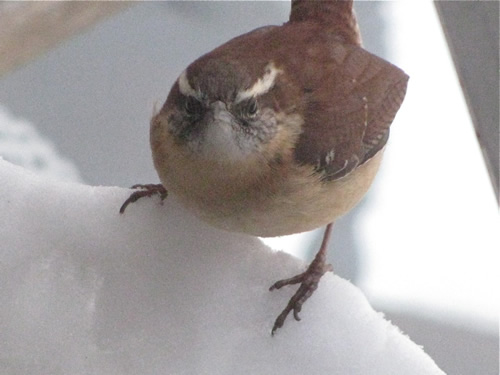
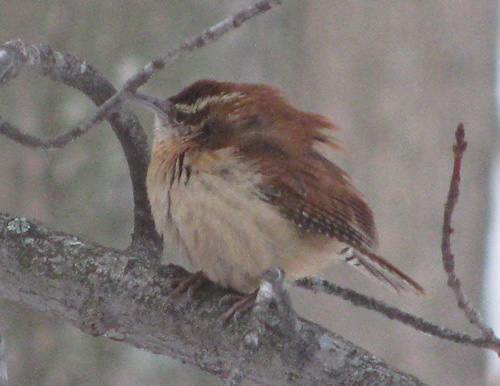
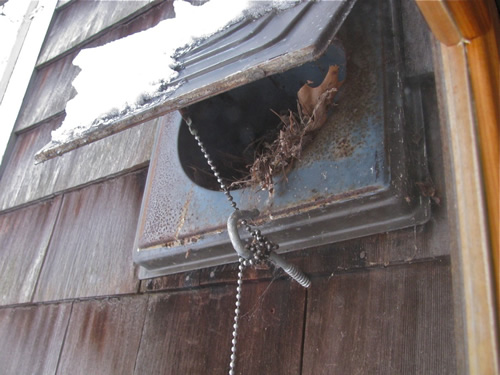
Observer: Josh Simons
Observation Date: 1/30/11
Observation Time: 1:30 p.m.
Observation Location: Moose Hill area
Common Name: Carolina Wren
Scientific Name: Thryothorus ludovicianus
Comments: For more than 70 years, no Carolina Wrens were recorded during a Christmas Bird Count in Vermont. Then, in 1975, two were spotted. After being observed sporadically on subsequent counts, the bird began making regular appearances in 1991, and its numbers increased steadily from 1999 to 2006. Once a southern species seen rarely during New England’s traditionally cold winters, the wren is now a regular. And it’s not alone. Milder winters and the earlier onset of spring have spurred a variety of species to spread their wings farther north, including Tufted Titmouse, Red-bellied Woodpecker, and Cape May Warbler.
More Information: Cornell Lab of Ornithology “All About Birds”
Observer: Paul Lauenstein
Observation Date: 4/24/24
Observation Time: 8:45 a.m.
Observation Location: Moose Hill Audubon Wildlife Sanctuary
Common Name: Carolina Wren
Scientific Name: Thryothorus ludovicianus
Comments: The Carolina Wren is sensitive to cold weather, with the northern populations decreasing markedly after severe winters. Global warming might be responsible for the northward range expansion seen in the late-1900s and early 2000’s.
A pair bond may form between a male and a female at any time of the year, and the pair will stay together for life. Members of a pair stay together on their territory year round, and forage and move around the territory together.
More Information: All About Birds
Observer: Paul Lauenstein
Observation Date: 4/25/20
Observation Time: 10:00 a.m.
Observation Location: Conservation land at Lakeview St. & Morse St.
Common Name: Carolina Wren
Scientific Name: Thryothorus ludovicianus
Comments: The Carolina Wren is sensitive to cold weather, with the northern populations decreasing markedly after severe winters. Global warming might be responsible for the northward range expansion seen in the late-1900s and early 2000’s.
A pair bond may form between a male and a female at any time of the year, and the pair will stay together for life. Members of a pair stay together on their territory year round, and forage and move around the territory together.
More Information: All About Birds
Observer: Paul Lauenstein
Observation Date: 5/15/15
Observation Time: 7:35 a.m.
Observation Location: Moose Hill Audubon Wildlife Sanctuary
Common Name: Cedar Waxwing
Scientific Name: Bombycilla cedrorum
Comments: These striking birds are typically seen in groups. Their tails look as if they were dipped in yellow paint. See:http://www.allaboutbirds.org/
Observer: Paul Lauenstein
Observation Date: 5/15/20
Observation Time: 6:45 a.m.
Observation Location: near Gavins Pond soccer parking area
Common Name: Cedar Waxwing
Scientific Name: Bombycilla cedrorum
Comments: These striking birds are typically seen in groups. Their tails look as if they were dipped in yellow paint.
More Information: http://www.allaboutbirds.org/
Observer: Deb Radovsky
Observation Date: 5/18/2016
Observation Time: N/A
Observation Location: Moose Hill area
Common Name: Cedar Waxwing
Scientific Name: Bombycilla cedrorum
Comments: Cedar Waxwings typically travel in groups.
More Information: All About Birds
Observer: Deb Radovsky
Observation Date: 8/2/20
Observation Time: 6:40 a.m.
Observation Location: along Lake Massapoag
Common Name: Cedar Waxwing
Scientific Name: Bombycilla cedrorum
Comments: Cedar Waxwings typically travel in groups.
More Information: All About Birds
Observer: Paul Lauenstein
Observation Date: 5/12/23
Observation Time: 7:20 a.m.
Observation Location: Moose Hill Audubon Wildlife Sanctuary
Common Name: Chestnut-sided Warbler
Scientific Name: Setophaga pensylvanica
Comments: Dazzling woodland warblers migrate through Sharon every spring on their way from South and Central America to Canada. Catching sight of one leaves an indelible impression.
More Information: All About Birds
Observer: Paul Lauenstein
Observation Date: 5/16/15
Observation Time: 8:20 a.m.
Observation Location: Moose Hill Audubon Wildlife Sanctuary
Common Name: Chestnut-sided Warbler
Scientific Name: Setophaga pensylvanica
Comments: Dazzling woodland warblers migrate through Sharon every spring on their way from South and Central America to Canada. Catching sight of one leaves an indelible impression.
More Information: All About Birds
Observer: Paul Lauenstein
Observation Date: 4/23/24
Observation Time: 9:30 a.m.
Observation Location: Moose Hill Audubon Wildlife Sanctuary
Common Name: Chipping Sparrow
Scientific Name: Spizella passerina
Comments: Chipping sparrows are common in Sharon. They have a distinctive reddish cap above a white eyeline. Their song is described as a reedy trill that sounds a lot like the songs of the pine warbler and the junco.
More Information: All About Birds
Observer: Paul Lauenstein
Observation Date: 4/28/23
Observation Time: 7:40 a.m.
Observation Location: Moose Hill Audubon Wildlife Sanctuary
Common Name: Chipping Sparrow
Scientific Name: Spizella passerina
Comments: Chipping sparrows are very common in Sharon. They have a distinctive reddish cap above a white eyeline. Their song is described as a reedy trill that sounds a lot like the songs of the pine warbler and the junco.
More Information: All About Birds
Observer: Paul Lauenstein
Observation Date: 5/20/13
Observation Time: 4:20 p.m.
Observation Location: Moose Hill Audubon Wildlife Sanctuary
Common Name: Chipping Sparrow
Scientific Name: Spizella passerina
Comments: Chipping sparrows are very common in Sharon. They have a distinctive reddish cap above a white eyeline. Their song is described as a reedy trill that sounds a lot like the songs of the pine warbler and the junco.
More Information: All About Birds
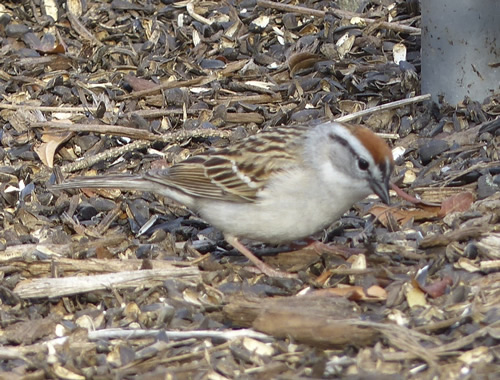
Observer: Deb Radovsky
Observation Date: 4/24/18
Observation Time: 5:00 p.m.
Observation Location: Moose Hill Audubon Wildlife Sanctuary, near bird feeders
Common Names: Chipping Sparrow and Dark-eyed Junco
Scientific Names: Spizella passerina and Junco hyemalis
Comments: If you want to get an idea of what birds are around, spend some time watching the feeders at the Moose Hill Audubon Wildlife Sanctuary. You’ll see everything from hummingbirds to wild turkeys.
More Information: All About Chipping Sparrows and All About Dark-eyed Juncos
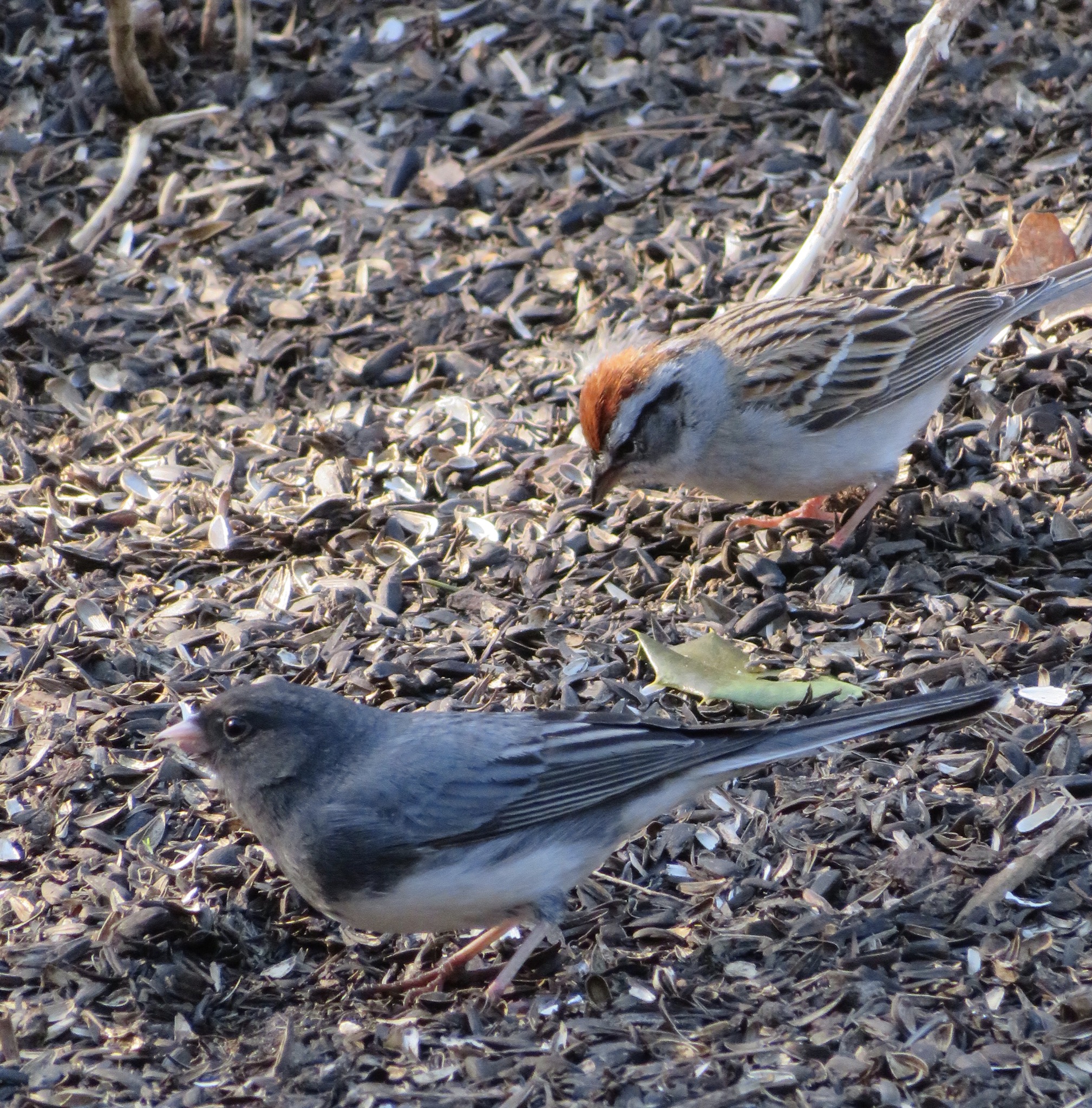
Observer: Wayne Gelfman
Observation Date: 7/24/23
Observation Time: around 6:00 a.m.
Observation Location: near Sharon Community Center
Common Name: Chukar
Scientific Name: Alectoris chukar
Comments: Chukars were introduced to the United States from Pakistan in 1893. Between 1931 and 1970, additional introductions in the western U.S. helped establish wild populations in 10 western states (California, Idaho, Nevada, Washington, Arizona, Colorado, Montana, Oregon, Utah, Wyoming) and in British Columbia, Canada. Now they are common in the western United States and British Columbia.
So what’s this one doing in Sharon? Was it released from captivity?
More Information: All About Birds
Observer: Paul Lauenstein
Observation Date: 4/23/24
Observation Time: 10:00 a.m.
Observation Location: Moose Hill Audubon Wildlife Sanctuary
Common Name: Common Grackle
Scientific Name: Quiscalus quiscula
Comments: Grackles are irridescent in the sunlight.
More Information: All About Birds
Observer: Ilan Fisher
Observation Date: 6/12/2018
Observation Time: N/A
Observation Location: near Lake Massapoag
Common Name: Common Grackle
Scientific Name: Quiscalus quiscula
Comments: I love this guy and he loves this feeder. With his yellow eyes and black cape, I call him “Count Gracula.” He is fun to watch.
More Information: All About Birds
Observer: Paul Lauenstein
Observation Date: 6/30/2014
Observation Time: 3:50 pm
Observation Location: near Gavins Pond
Common Name: Common Grackle
Scientific Name: Quiscalus quiscula
Comments: You might see a Common Grackle hunched over on the ground, wings spread, letting ants crawl over its body and feathers. This is called anting, and grackles are frequent practitioners among the many bird species that do it. The ants secrete formic acid, the chemical in their stings, and this may rid the bird of parasites.
More Information: All About Birds
Observer: Deb Radovsky
Observation Date: 2/26/18
Observation Time: N/A
Observation Location: Lake Massapoag
Common Name: Common Merganser
Scientific Name: Mergus merganser
Comments: Common Mergansers are sometimes called sawbills, fish ducks, or goosanders. The word “merganser” comes from the Latin and roughly translates to “plunging goose”—a good name for this very large and often submerged duck.
Young Common Mergansers leave their nest hole within a day or so of hatching. The flightless chicks leap from the nest entrance and tumble to the forest floor. The mother protects the chicks, but they catch all of their own food. They start by diving for aquatic insects and switch over to fish at about 12 days old.
More Information: All About Birds
Observer: Paul Lauenstein
Observation Date: 5/5/18
Observation Time: 6:00 p.m.
Observation Location: Moose Hill Audubon Wildlife Sanctuary
Common Name: Common Raven
Scientific Name: Corvus corax
Comments: Ravens are considerably larger than crows. Their call is different and they travel in pairs, unlike crows, which travel in larger groups. For more information, see: http://www.audubon.org/field-guide/bird/common-raven. Sharon is at the southern edge of the raven’s range. Be sure to scroll down and check out the map showing how the raven’s range is expected to retreat northward as the climate heats up.
More Information: All About Birds
Observer: Paul Lauenstein
Observation Date: 5/11/18
Observation Time: 8:35 a.m.
Observation Location: Moose Hill Audubon Wildlife Sanctuary
Common Name: Common Yellowthroat
Scientific Name: Geoothlypis trichas
Comments: Common yellowthroats are typically found in or near wetlands. They are a type of warbler, with a distinctive black mask that is reminiscent of a raccoon. Their song sounds like, “witchety, witchety, witchety.”
More Information: All About Birds
Observer: Paul Lauenstein
Observation Date: 5/11/20
Observation Time: 10:00 a.m.
Observation Location: near Billings Brook wetlands under the high tension lines across the street from Gavins Pond soccer fields
Common Name: Common Yellowthroat
Scientific Name: Geoothlypis trichas
Comments: Common yellowthroats are typically found in or near wetlands. They are a type of warbler, with a distinctive black mask that is reminiscent of a raccoon. Their song sounds like, “witchety, witchety, witchety.”
More Information: All About Birds
I took this photo at the same place two days later:
Observer: Paul Lauenstein
Observation Date: 5/11/23
Observation Time: 9:30 a.m.
Observation Location: Moose Hill Audubon Wildlife Sanctuary (boardwalk)
Common Name: Common Yellowthroat
Scientific Name: Geoothlypis trichas
Comments: Common yellowthroats are typically found in or near wetlands. They are a type of warbler, with a distinctive black mask that is reminiscent of a raccoon. Their song sounds like, “witchety, witchety, witchety.”
More Information: All About Birds
Observer: Paul Lauenstein
Observation Date: 5/14/14
Observation Time: 2:35 p.m.
Observation Location: Moose Hill Audubon Wildlife Sanctuary
Common Name: Common yellowthroat
Scientific Name: Geothlypis trichas
Comments: This masked warbler is typically found near wetlands or ponds.
More Information: All About Birds
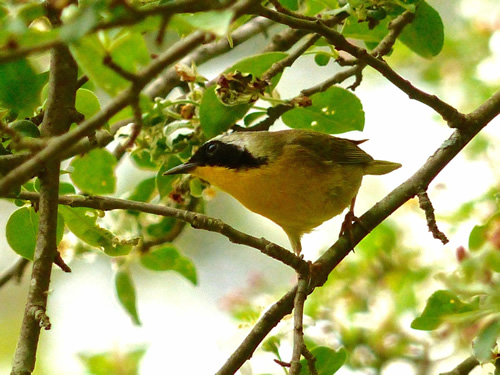
Observer: Paul Lauenstein
Observation Date: 5/15/15
Observation Time: 10:45 a.m.
Observation Location: Moose Hill Audubon Wildlife Sanctuary
Common Name: Common Yellowthroat
Scientific Name: Geoothlypis trichas
Comments: Common yellowthroats are typically found in or near wetlands. They are a type of warbler, with a distinctive black mask that is reminiscent of a raccoon. Their song sounds like, “witchety, witchety, witchety.”
More Information: All About Birds
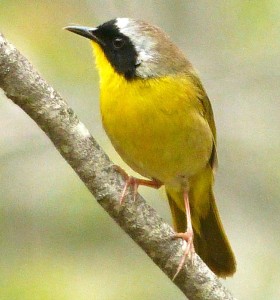
Observer: Paul Lauenstein
Observation Date: 5/26/19
Observation Time: 1:30 p.m.
Observation Location: Moose Hill Farm (formerly the Kendall Estate)
Common Name: Common Yellowthroat
Scientific Name: Geoothlypis trichas
Comments: Common yellowthroats are typically found in or near wetlands. They are a type of warbler, with a distinctive black mask that is reminiscent of a raccoon. Their song sounds like, “witchety, witchety, witchety.”
More Information: All About Birds
Observer: Paul Lauenstein
Observation Date: 10/1/11
Observation Time: 9:10 a.m.
Observation Location: 4 Gavins Pond Road
Common Name: Cooper’s hawk
Scientific Name: Accipiter cooperii
Comments: This juvenile female Cooper’s hawk alit in the dogwood tree right outside my living room window as I was working at my desk. Without getting up, I reached for my camera and snapped this photo through the window just before it flew away.
Cooper’s hawks look like Sharp-shinned hawks, but Cooper’s hawks have a more rounded tail. Also, the streaks on the breast of a juvenile Cooper’s hawk are narrower than those on the breast of a sharp-shinned hawk.
More Information: All About Birds
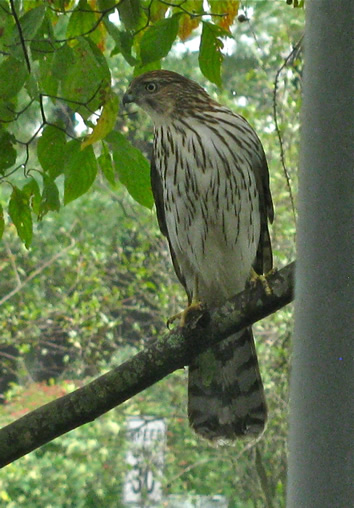
Observer: Paul Lauenstein
Observation Date: 8/18/12
Observation Time: 5:20 p.m.
Observation Location: 4 Gavins Pond Road (back yard)
Common Name: Cooper’s hawk
Scientific Name: Accipiter cooperii
Comments: This Cooper’s hawk perched on a branch in my back yard, and I photographed it through the window. Note the rounded tail, which differentiates it from a sharp-shinned hawk.
More Information: All About Birds
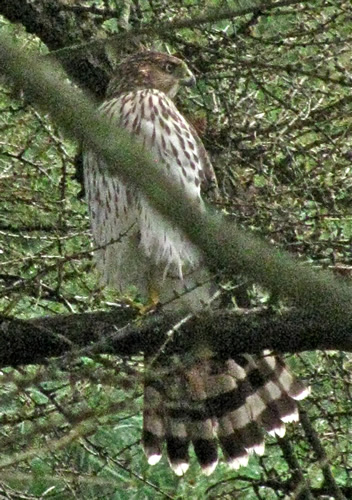
Observer: Josh Simons
Observation Date: 1/1/09
Observation Time: 2:00 p.m.
Observation Location: Moose Hill Parkway
Common Name: Dark-eyed Junco
Scientific Name: Junco hyemalis
Comments: This and the titmouse and wren photos were all taken with a Canon 50D and a Canon 500mm f4 lens from the comfort of my kitchen on Moose Hill Parkway. We have feeders that attract lots of birds who land on a nearby lilac bush while waiting for their turn at the feeders.
In terms of processing, I use very little. The images are cropped and very small
adjustments are made to exposure and contrast with sometimes a little extra
sharpening applied.
That and the nice, slanting winter sunlight are all there is to it.
More Information: Cornell Lab of Ornithology “All About Birds”
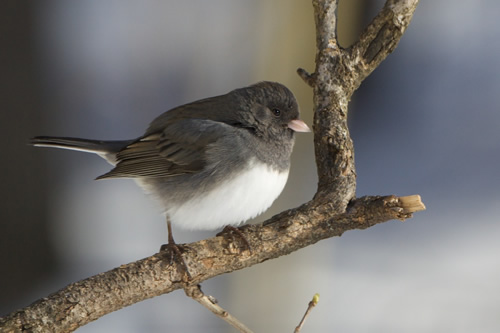
Observer: Paul Lauenstein
Observation Date: 12/18/20
Observation Time: 8:35 a.m.
Observation Location: Gavins Pond Rd. (our back yard)
Common Name: Dark-eyed Junco
Scientific Name: Junco hyemalis
Comments: Juncos are a type of sparrow commonly seen around Sharon in winter. They head north in spring and don’t return until fall.
More Information: Cornell Lab of Ornithology “All About Birds”


